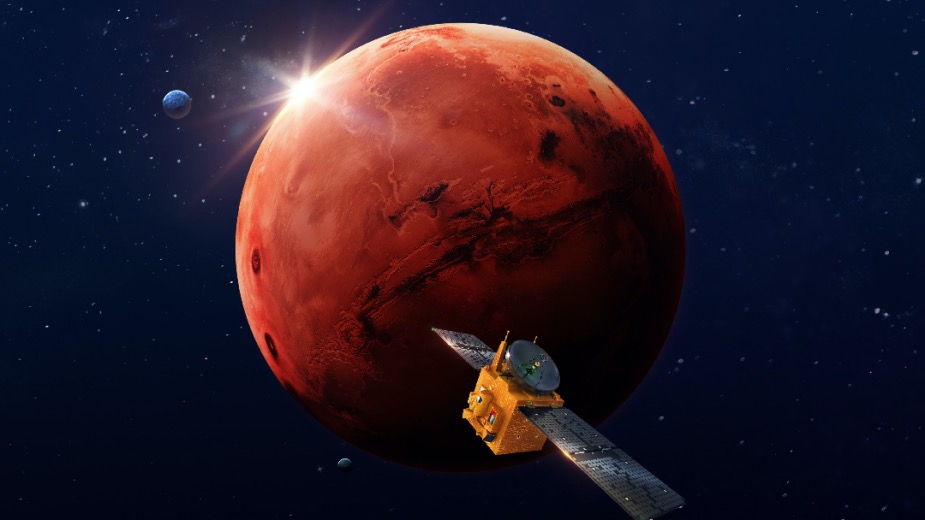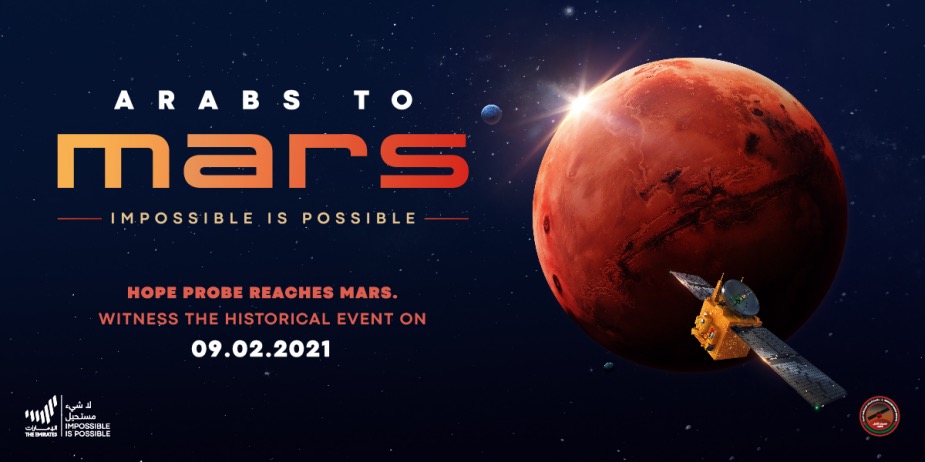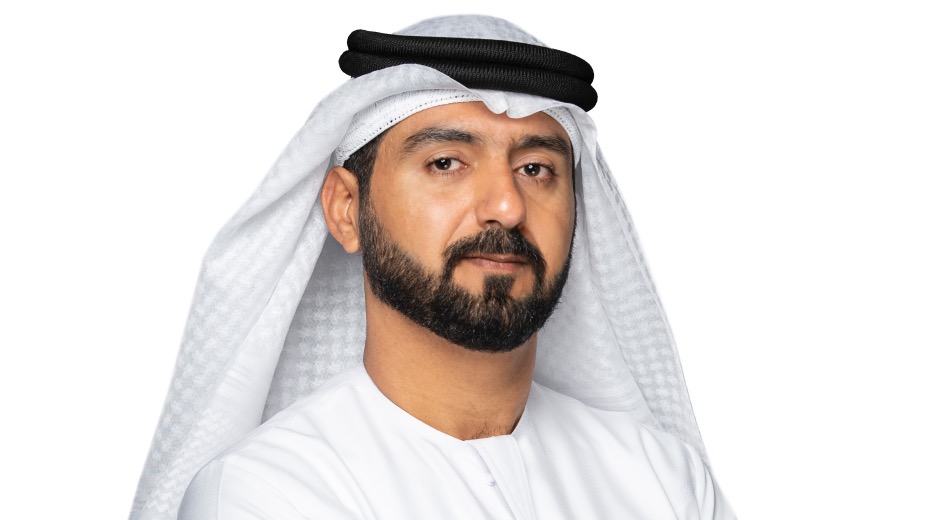
Paint the Town Red: How Creativity Boosted the UAE’s Mission to Mars

For centuries, the Red Planet has captured the human imagination and inspired creativity. Composer Gustav Holst channelled Mars through the rumbling of timpani drums and sharp blasts of the brass section. Science fiction writers, from H.G. Wells to Ray Bradbury, have woven stories of aliens and adventure in response to the fourth rock from the sun. In 2021, Mars has lost none of its power as a creative muse.
This February, the UAE erupted in a symphony of creativity in celebration as its probe Hope finally entered orbit. The probe is part of the Emirates’ Mission to Mars (EMM) and is being viewed as a milestone for the Arab world. The UAE is just the fifth nation to get to Mars.
But the government of the UAE wasn’t content to let this momentous event simply become a nice news story that would soon slip from the public imagination. Instead, they were inspired to launch a series of creative, playful, and ambitious activities to enthuse and engage people, to generate a feeling of togetherness and hope at home and to spark a future generation of scientists, engineers, inventors and entrepreneurs.
If the intention was to break through the clutter, the team certainly achieved that. Buzz was generated online with the First Emoji Pledge, where people were encouraged to send messages of support to Hope. Babies born on the day that Hope entered orbit were given ‘Future Astronaut’ sleep suits. Arrivals to Dubai airport had their passports stamped with ‘Martian Ink’, made from local red rock. And, in possibly the most audaciously, deliciously sci-fi move, they brought Mars’ twin moons Phobos and Deimos to the skies of Dubai.
Khaled AlShehhi is executive director of marketing and communications at the UAE Government Media Office, and he has been conducting a full orchestra of creative agencies as they brought the magic of Mars to Earth. He explains why creativity is so important to the Emirates Mars Mission and the UAE’s post-oil future.
LBB> How significant is the Mars probe for the UAE and for the Arab world generally?
Khaled AlShehhi> Hope, the UAE’s probe to Mars, is the spacecraft at the heart of the Emirates’ Mission to Mars (EMM). The Mission is a strategic initiative announced by the United Arab Emirates’ President His Highness Sheikh Khalifa Bin Zayed Al Nahyan and UAE’s Vice President and Prime Minister and Ruler of Dubai, His Highness Sheikh Mohammed Bin Rashid Al Maktoum on 16th July 2014. It was launched to accelerate the development of the UAE’s space, education, science and technologies sectors.
The Hope probe will build the first full picture of Mars’ climate and atmosphere throughout a full Martian year for the first time. Analysing the atmospheres of other planets allows us to better understand our own. The data and the learnings from it will be shared with the global scientific community, helping humanity find solutions to our own climatic challenges.
The programme was also timed to mark the UAE’s Golden Jubilee, as the country celebrates its first 50 years in 2021. It also represents its vision for its post-oil future, building its wealth on knowledge and empowering the youth in the fields of science and technology.
Soon after sending its first satellites into space, the UAE is taking Arab pride all the way to Mars. We are the fifth individual nation to reach the Red Planet, joining an elite group of countries and entities that includes the USA, the Soviet Union, the European Space Agency China and India.
LBB> Why did you decide that you wanted to celebrate the mission using creative activations? Did you have any specific outcomes in mind?
Khaled AlShehhi > The UAE is the latest member of an elite group of nations that have sent probes to Mars. For such a young nation, it is an amazing feat that warrants attention and recognition, as well as pride for all Arabs.
It would have been easy and conventional to have it stay within scientific circles and treat it as a news item, but we wanted to involve the public and involve them in this mission. Remember the objectives, it’s as much a scientific mission as it is a societal one for everyone in the UAE and the region.
Our goal was to connect people across the country and beyond to the mission, so we used different touchpoints and activations to engage with different target audiences, including travellers to the UAE. To create awareness and stimulate interest and engagement, we’ve learned from experience that creativity achieves the cut-through we need to meet our ambitions.
Creativity in thinking and in execution breaks through the clutter and the apathy, engages people and changes perceptions and behaviours.
LBB> How did you decide which activations to pursue?
Khaled AlShehhi > Our core mission was to get people to sit up and pay attention, engage them, educate them and invite them to celebrate together. So, we decided to bring emotion into the scientific event and humanise our communication to make it appealing to the public, above and beyond scientists and journalists.
Hope’s odyssey is a major endeavour of astronomical scale. To make people care about a 1.35-ton spacecraft the size of a car 500 million kilometres away required us to stimulate empathy, pride, apprehension, anticipation, surprise and joy with our plans. These were the filters we used to screen the many ideas we reviewed to create a multi-layered plan for the critical 27-minute-long autonomous Mars Orbit Insertion (MOI) phase.

More than just awareness, we wanted people to engage with and share our activations to create this warm sense of togetherness and belonging. From watching a powerful video and how hope is transforming our lives to countless buildings turning red across the region, we not only educated but rallied people behind the mission. Whether it be the First Emoji Pledge or the Double Moon in the sky, we created conversations, debate, buzz even to the point where people rooted for Hope. We also created memories of this momentous day with the Martian Ink stamps and baby space suits to celebrate other meaningful arrivals.
LBB> It looks like you worked with a range of different agencies too – how did you go about orchestrating that?
Khaled AlShehhi> In some way, we replicated the team behind the mission, assembling a group of local experts and collaborating with international partners, to achieve success. We were all driven by the same energy and passion. Maybe it’s the fact it’s an historic space mission, we all dreamed of being space explorers ourselves. Multiple agencies were involved, each with their specific strength, one handling the core message, others managing the tactical activations to deliver on individual goals. One dealt with influencer marketing and others assigned with different tasks.
The point is to brief all the agencies together at the same time and make sure they have the means to collaborate. It’s about cross-pollination and emulation, as well as organising the workflow so that everything falls into place. You need people who keep an eye on the whole and others on the details, working closely together. The synergy between teams is essential, they need to work as one because they all depend on each other, driven by the same goal. The dedication was impressive and it’s probably because everyone was emotionally involved too.
LBB> How did you orchestrate all of the activations?
Khaled AlShehhi> We started with emotionally charged videos on social media. These put the Mars Mission into a developmental context, dramatised the MOI and asked people to send messages of support to Hope with the First Emoji Pledge. We then moved to a more experiential phase.
We brought Mars’ two moons, Phobos and Deimos, into Dubai’s sky [with agency MullenLowe]. The mysterious and unexplained phenomenon gave rise to much chatter in social and traditional media before we revealed it was an innovative activation. It required a sky projection never done before in the Middle East. This was the most challenging operation of all as usually you project on a surface like a wall or water. This was never tested in a desert with dust and wind. The brief was also to ensure the projection was realistic and visible from long distances, so we went location scouting across the UAE to find the best, dark spot. We trekked across mountains, deserts and cities, before selecting a desert area in the outskirts of Dubai. We used two giant 70m cranes to hoist a 40m holo screen in the air under the cover of darkness. The result was so impressive that people shared what they saw on social media and the story was soon relayed by media.
Another exciting activation is the commemorative passport stamp for arriving passengers on February 9th, the day of the MOI, using ‘Martian Ink’ [created by TBWA\RAAD]. It’s a red ink made from volcanic basalt rocks from the UAE desert. It’s never been done before but since these rocks are similar to those found on Mars, giving the planet its red colour, this was too good an opportunity to miss, despite the challenges.
We studied the geology of Mars and Earth, consulting gemmologists and geologists to find the rocks that would most resemble those on Mars. To turn these into ink was a long and delicate process. The rocks were crushed and turned into fine paste with the help of a marble pestle. The mix was then air-dried and the powder then extracted with talc fineness. It was then mixed with adhesive additives to create a rusty red semi-liquid ink. Once ready, the ink was tested and transferred to the ink pad sets with a rubber seal - ready to be stamped on the paper surface of passports in the shape of the final design that we created specifically for this stamp. Its message and design connected travellers’ arrival to the UAE to the country’s arrival at Mars.
LBB> What has been the public response and impact of these activations?
Khaled AlShehhi > The MOI could have stayed a scientific event of interest to a limited circle of scientists and journalists, but we turned it into an emotionally charged moment of pride and shared excitement. With a steady stream of creative and innovative activities, we built anticipation and democratised a distant feat, allowing the public to share in it. With over 12,000 local, regional and international media reports on the Hope Probe’s arrival to Mars and 2.7 billion impressions with #ArabstoMars, topping online trends, attention was clearly sky high.
As well as major engagement, there is plenty of anecdotal evidence of how enthused people have been by the campaign. People have requested for the Martian Ink stamp in their passport in the following days of the operation, parents have also been asking for a space suit. Social listening has shown a massive interest in the MOI and the pride it has generated.
The real impact is more long term though. It will be in the careers it will inspire, in the future accomplishments it will instigate, in the future it will shape.
LBB> Covid-19 has made the past year difficult in many ways - was that an extra motivating factor to create a moment of joy around the Mars Mission?
Khaled AlShehhi> Despite the onset of Covid last year, we were all determined to remain true to our nation brand promise of “Impossible is Possible”. Covid has certainly proved challenging, forcing us to adapt, but we didn’t let it stop us. Be it the successful launch of Hope in July, the starting up of the first nuclear power plant in August, or the impressive roll-out of our vaccination programme, one of our victories against the virus, 2020 has been yet another year of achievements.
More than creating a moment of joy, our ultimate motivation was our determination to overcome challenges, be they planned or not. But like everyone else, we also kept looking at the stars in the sky, hoping and wishing for better tomorrows. Hope’s successful MOI was certainly a reason for celebration.

LBB> Tell me about the goals of your department and for your role more generally?
Khaled AlShehhi> The UAE Government Media Office develops and implements strategic plans and policies to increase the influence and outreach of various government initiatives and projects with local, regional and global dimensions. I joined the organisation in 2015 to lead its digital communications and contribute to strengthening the UAE’s reputation as an incubator for pioneering developmental, humanitarian, cultural and knowledge projects. Together with my team, we take on major projects for the UAE Government and inspire, motivate, uplift and persuade people at scale through creative and effective communications.
The last year has been fascinating, as we explored new fields, most notably, humanitarian endeavours. I never expected to lead the digital elements of key projects that brought people together, like what we did during the Covid-19 outbreak. This is a very fulfilling and stimulating role.
Several major initiatives that come to mind, especially our digital campaigns for innovative humanitarian projects, for example, the World’s Tallest Donation Box and the Well of Hope initiative. The First Arabic Countdown campaign marked the launch of the Emirates’ Hope Probe mission to Mars. Earlier, I also managed the digital strategy of key projects including the UAE Nation Brand, the 2017 “Year of Giving” and the 2016 “Year of Reading”, among many others.
This is a fresh perspective on governmental communications. It shows the ambition that runs through our leadership and I am honoured to play my part in delivering our country’s meaningful messages to and engaging with local, regional and even global audiences. To maximise the reach and impact of these exciting key initiatives, I keep pushing higher in terms of creativity and performance.
LBB> Looking at the Mars work and also previous projects like the Tallest Donation box, it seems that you have a real belief in the power of creative ideas to help Dubai and UAE. What role does creativity play in UAE’s strategy?
Khaled AlShehhi> Innovation is the result of creative thinking, made possible by a stimulating and supportive culture that comes straight from the top. We’re very fortunate to have visionary leaders who value innovation as a major stepping stone towards progress. The modernisation of government, the digitisation of services and the transformation of our infrastructure have all been guided by the Vision 2021 plan.
After the UAE Government initiative in 2013, H.H. Sheikh Mohammed Bin Rashid Al Maktoum launched the UAE National Innovation Strategy in 2014. The ambition was to turn the UAE into one of the most innovative nations in the world within seven years. The government’s strategy was to improve the quality of life, increase economic diversification, develop the knowledge economy, enhance competitiveness, create high skilled jobs and promote entrepreneurship.
If you consider the improvements made in the last seven years with our institutions and regulatory environment, innovative products and services, knowledge and technology, and infrastructure, we’re meeting our ambitions. This is also proven by the latest IMD World Competitiveness Centre report.
In other words, creativity is not a new mantra for us, it’s been with us since the formation of the country 50 years ago.













